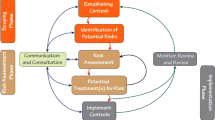Abstract
There is general belief that the rate of firefighter injury can be lowered by creating fire service cultures where firefighters more closely follow their training and standard operating guidelines (SOGs). That is, there is a desire to minimize cases where firefighters operate outside of the SOGs. Interestingly, there is scant data on the rate of adherence to SOGs in the fire service. In an attempt to better understand the compliance to fireground standard operating guidelines, an analysis of firefighter compliance to Austin Fire Department’s guidelines was performed. We analyze over 1000 survey responses taken from Austin firefighters on fireground operations over a 1.5 year time frame. This paper does not critique the department’s procedures or the officers’ actions, but simply reports the compliance data and discusses some implications of the data. Austin Fire Department (AFD) in the process of creating their current version of standard operating guidelines developed an initial tactical function assignment rule called the “90/10” rule. This rule states that in 90% of situations, personnel are expected to comply with their SOG specified initial tactical functions. Although this rule was proposed several years ago there had not been testing to indicate if the rule was being upheld. By analyzing the initial tactical functions, we first discuss the rate of adherence to the 90/10 rule. We then conducted a more in-depth study to test if other SOG directives (e.g., tactics) are complied to with the same frequency. There were three specific tactics studied – a size-up tactic, a primary firefighter safety tactic, and a fire attack tactic - which had varying ranges of compliance compared to the “90/10” rule. After examining the compliance data, computer simulations were conducted on the fire attack tactic to better understand how a change in the tactic could affect firefighter working conditions.













Similar content being viewed by others
References
National Fire Protection Association, “NFPA 1500 Standard on Firefighter Occupational Safety and Health”, 2002 edn.
IOCAD Emergency Services Group, “The Guide to Developing Effective Standard Operating Procedures for Fire and EMS Departments”, EME-98-CO-0202. Federal Emergency Management Agency’s United States Fire Administration.
Brunacini A.V. (2002) Fire Command 2nd edn. National Fire Protection Association, Quincy MA
Svensson S. (2002) The Operational Problem of Fire Control. Department of Fire Safety Engineering, Lund University, Sweden
J. Albus, “Engineering of Mind: An Introduction to the Science of Intelligent Systems”, Wiley-Interscience, 2001.
Bigley G.A., Roberts K.H. (2001) The Incident Command System: High Reliability Organizing for Complex and Volatile Task Environments. Academy of Management Journal 44:1281–1300
Endsley M.R., Garland D.J. (2000) Pilot Situation Awareness Training in General Aviation. SA Technologies, Inc., Marietta, Georgia
J. Evans, “Standard Operating Guideline: Fireground Operations”, A01-D. Austin Fire Department Policy and Procedure, March 1, 2004.
Hodous T.K., Pizatella T.J., Braddee R., Castillo D.N. (2004) Fire Fighter Fatalities 1998–2001: Overview with an Emphasis on Structure Related Traumatic Fatalities. Injury Prevention 0:222–226
J. Evans, “Standard Operating Guideline: Two-in/Two-out”, E02-C. Austin Fire Department Policy and Procedure, October 10, 2006.
J. Evans, “Standard Operating Guideline: Ventilation”, A03-A. Austin Fire Department Policy and Procedure, October 10, 2006.
R. Nicks, “FIRE Form – Fireground Incident Review and Evaluation Form”, Austin Fire Department, January 20, 2004.
J. Evans, “Standard Operating Guideline: Post Incident Review;” A07-B. Austin Fire Department Policy and Procedure, October 2, 2006.
S. Stephen, “Walton William Characterizing Positive Pressure Ventilation using Computational Fluid Dynamics”, NISTIR 7065. February 2003.
O.A. Ezekoye, C.H. Lan, R. Nicks, “Positive Pressure Ventilation Attack for Heat Transport in a House Fire”, 6th ASME-JSME Thermal Engineering Joint Conference, TED-AJ03–409, 2003.
S. Kerber, and W. Walton, “William Effect of Positive Pressure Ventilation on a Room Fire”, NISTIR 7213. March 2005.
Quintiere J. (2006) Fundamentals of Fire Phenomena. Wiley, West Sussex, England, p 396
Author information
Authors and Affiliations
Corresponding author
Rights and permissions
About this article
Cite this article
Weinschenk, C., Nicks, R. & Ezekoye, O.A. Analysis of Fireground Standard Operating Guidelines/Procedures Compliance for Austin Fire Department. Fire Technol 44, 39–64 (2008). https://doi.org/10.1007/s10694-007-0025-5
Received:
Accepted:
Published:
Issue Date:
DOI: https://doi.org/10.1007/s10694-007-0025-5




